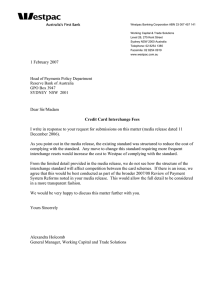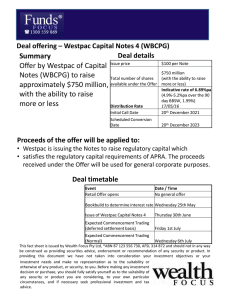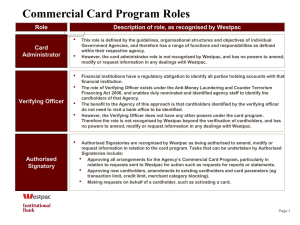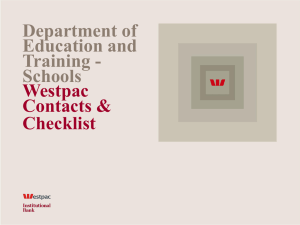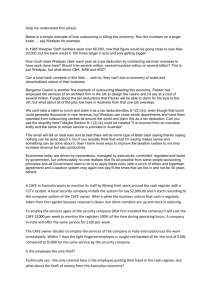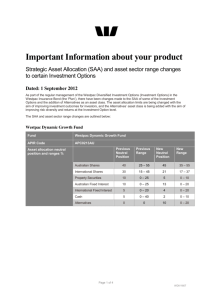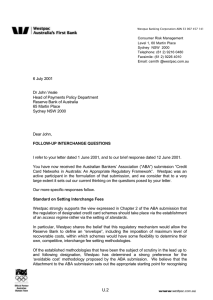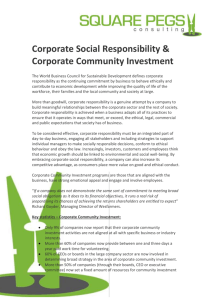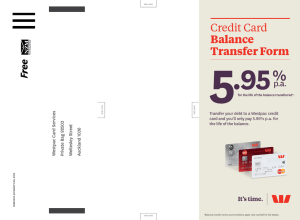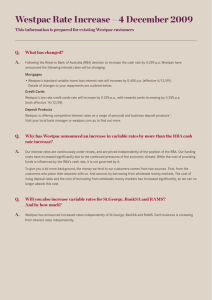Mainstreaming Flexibility At Westpac Group
advertisement
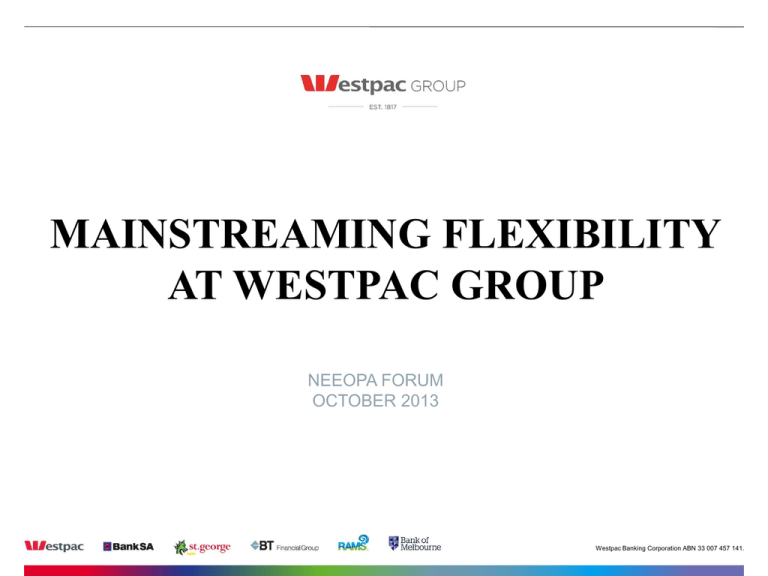
MAINSTREAMING FLEXIBILITY AT WESTPAC GROUP NEEOPA FORUM OCTOBER 2013 Westpac Banking Corporation ABN 33 007 457 141. Flexibility at the Westpac Group and our 2017 strategy Making agile and flexible working a widespread and successfully embedded best practice is a key business priority for our 2017 Strategy To grow in a targeted way and ensure we remain strong, we need to: • Be agile to meet our customer needs • Mainstream flexibility for everyone • Show leadership and best practice • Focus on productivity and sustainability • Pull together as one team 2 2012 Diversity & Flexibility Survey Results on Flexibility For Westpac Group employees, being able to work flexibly is a key priority • 62% of employees participate in flexible work arrangements, up from 44% in 2010. • Fewer flexibility requests rejected (from 11% to 7.5%). • Largest increase in uptake is working from home and irregular flexible work practices. • Most agreed that people working flexibly can deliver on customer needs and supported continuation of flexible work arrangements. • 82% of people indicated they would want to use some form of flexibility in the next 3 years, compared with a projection of 58% in 2010. Of this, Over 50% of employees would like to utilise flexible hours (current uptake 25%). 3 What is flexibility? • What does it mean to you? 4 Common Flex Options at Westpac Group Some options currently being undertaken by people at the Westpac Group are: • Part time • Job share (sharing the responsibility for one role between two people) • Flexible hours (flexible start and finish times and taking some hours off during the day and working them back in later) • Flexible leave days • Compressed hours or work week (e.g. 10 hour day for 3 days per week) • Mobile working regularly (work away from the office) • Mobile working occasionally (work away from the office) • Career break/extended leave (for up to 12 months) • Additional leave • Flexible career (being able to ramp up or ramp down career) • Purchased leave 5 The World is Changing The nature of our workplace and how and when we work is evolving. From the time flexibility was introduced to now, the drivers behind flexibility have changed In the beginning Recent years Now and into the future • Recognition that flexibility was needed for some people to participate in the workforce. • The need for flexibility extended to working parents, mature age employees and those with carer needs of any kind • People want to work flexibly for any reason – at all levels and all ages, regardless of carer needs • Part time and working from home for working mums • Flexibility has extended to a broader range of options and often a mix of a number of methods of working flexibly • The benefits of flexibility are being recognised - for people, the business, customers 6 • Flexibility is becoming a standard business practice • Flexibility will be key to productivity, sustainability and performance Our Mainstreaming Flexibility toolkit guiding principles 1. Flex is an individual construct 2. Approach flexibility at a team level 3. The opportunity to request flexibility is for everyone 4. Tools, policies and processes should be easy to use and implement 7 Flexibility as a standard business practice Evidence of quality flexibility and careers as a standard business practice • • The Westpac Group proactively sponsored industry leading research to drive and inform the flexibility agenda, with the Diversity Council Australia. 1. Flexibility is a tool for increasing business performance. 2. Everyone, at all levels, has an opportunity to engage in flexibility. 3. All forms of flexibility are engaged in. 4. Flexibility is engaged for any reason. 5. There is a culture of flexibility that attracts and retains talent. 6. There is a proactive approach to flexibility that is evident in both the business strategy and in management behaviour. 7. Flexibility is evident in both formal and informal processes. 8. Those who engage in flexibility progress in their careers. 9. The approach to flexibility is dynamic, adapting to the changing needs of the individuals and the organisation. The study identified 10 essential elements for embedding flexibility Source: Diversity Council of Australia, Get Flexible: Mainstreaming Flexible Work in Australian Business (2012) 10. Flexibility is based on trust. 8 The Top 10 success factors in implementing flexible work at the Westpac Group 1. Treating each request individually 2. Involving the team 3. Finding the wins and sharing stories 4. Creativity and innovation 5. Establishing clear expectations and responsibilities 6. Trust 7. Openness and dialogue. 8. Relationships and connection 9. Responding to changing needs 10. Full use of technology 9 What is your experience? • What are the main barriers to flexibility? • What specifically occurs? • What are the common comments or complaints? 10 Skill versus Will Skill: Will: • Implements flexibility effectively • Awareness of the need for flexibility • Innovates - review and improve • Engagement in the benefits In looking at your experiences, where do the barriers lie? 11 Skill versus Will – what development and support is required? Do your leaders and people require assistance with ‘how’ to mainstream flexibility or does it require a shift in mindset or ‘will’? Will ‘want to’ High level of awareness and engagement and low level of skill What to do: guide on ‘how to’ implement flexibility High level of awareness and engagement and skillfully embedding flexibility What to do: coach to stretch goals and encourage innovation Low level of awareness and engagement and low level of skill High level of skill and low level of awareness and engagement What to do: coach for a shift in mindset and direct on process What to do: coach for a shift in mindset and focus on benefits Skill ‘can do’ Adapted from Max Landsberg’s Skill Will Matrix 12 A coaching process - using GROW to coach leaders on the journey 1. Goal What you could say 2. Reality 3. Options 4. Wrap Up Lets first look at some ideal outcomes so we know what we are working towards In order to understand the gap between where you are now and where you want to be, lets have a look at the current situation Rather than jumping straight into solution mode, lets have a look at what options you might have so we know we are taking the best course of action Lets look at where to from here, what we need to do and how we’ll make sure you have the support you need • What is the ideal outcome for: • The individual? • You? • The team? • Stakeholders? • The business? • Customers? If there were no obstacles, what would the ideal outcome be? • What is the real, underlying issue? What is the cause of that? What other reasons could there be for this issue? What are the needs of the person involved? What would (person) say about the situation? If that issue was resolved, would this problem be solved? • • Jumping to solution mode. Putting up obstacles focusing on the challenge Not knowing the ideal outcomes of all parties No link to strategy • Making assumptions about cause-effect. Lack of understanding of the needs of the individual or team member Not having sufficient information • Questions you could ask • • • Things to look out for • • Outcome A clearly defined goal in line with business strategy • • • • • • • Challenge assumptions and a true understanding of the current situation • • • • What options are there to achieve this goal and solve the problem? What have you already tried? What else could you do? What could you do that has not been tried before? What are the possibilities? • • • • • • Sufficient consideration to options available Not thinking outside the square – sticking to old ways Sufficient consideration to options available and selection of the best solution • • Given the outcome to be achieved, what is the best option here? What combination of options might be appropriate? What support or resources do you need? What are the risks? What might we need to think of in advance? When will we follow up? How will you review success? Anything that might get in the way of follow through Any risks that might need to be managed Agreed actions and follow up Where to next? •Design the journey: – From and to – Step by step •Be a part of the journey: – Measure the benefits – Adjust for success 14 Questions and wrap up Thank you 15
